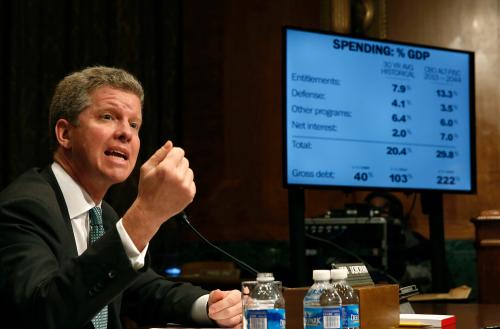The following brief is part of Brookings Big Ideas For America—an institution-wide initiative in which Brookings scholars have identified the biggest issues facing the country and provide ideas for how to address them.
 In the early 1990s the Clinton administration ran a large-scale government reform program that introduced websites, performance metrics, and other new ideas into government. The two presidents since then have been preoccupied with a terrorist attack on the homeland and the biggest recession since the Great Depression. The immediacy of those crises pushed major, widespread governmental reform to the back burner of the president’s attention, although in each administration there were important management initiatives. After two decades of war and recession, it is time for the next administration to evaluate the government in the light of the new century.
In the early 1990s the Clinton administration ran a large-scale government reform program that introduced websites, performance metrics, and other new ideas into government. The two presidents since then have been preoccupied with a terrorist attack on the homeland and the biggest recession since the Great Depression. The immediacy of those crises pushed major, widespread governmental reform to the back burner of the president’s attention, although in each administration there were important management initiatives. After two decades of war and recession, it is time for the next administration to evaluate the government in the light of the new century.
There are three ways to approach reform.
- To focus on governmental systems that cut across all governmental departments and agencies, such as hiring, purchasing, revenue raising, and budgeting.
- To focus on individual operations of government, such as sending out Social Security checks, landing airplanes safely, tracking down fruit and vegetables that cause disease outbreaks, or investigating gun crimes.
- To ask some big questions about what the government should or should not be doing in the 21st century. For instance, should the federal government be involved in housing policy, or is this a question best left to states and localities?
All three of these things are important aspects of a comprehensive approach to government reform. The first two require significant management expertise and the third requires significant political will. This chapter will begin by examining the first set of questions.
A COMPREHENSIVE APPROACH TO GOVERNMENT REFORM
A government-wide reform agenda should begin with:
- The budget process. Our federal budget process has not been reformed since 1974. While it worked well for a while, in recent years it has broken down completely. In the meantime, a third type of budgeting has gone on through the tax system and stands completely outside of the budget process. Budget reform must include tax expenditures
- Federal contracting. In the past two decades, more and more government functions have been done under contract by nongovernmental employees. Much of this has been driven by ideology, not by what is cost effective and right for citizens. It is time to ask what makes sense in federal contracting and to review the distortions that have resulted.
- The civil service. The civil service was built for a government of clerks, not for a government of professionals. It cannot compete for the talent it needs in today’s marketplace. We have been penny wise and pound foolish when it comes to the civil service. It is time to “normalize” the federal civil service so that it more closely resembles the overall labor market.
- Federal regulation. The federal regulatory system is obsolete and cannot keep up with the pace of change going on in many sectors of the American economy. This is especially evident in the sectors of the economy that are undergoing rapid technological change.
- Scoring issues. The Office of Management and Budget (OMB) and the Congressional Budget Office (CBO), the mandarins of the federal system, have a consensus on a set of scoring rules that from time to time cause irrational spending decisions on the part of the federal government. It is time to revisit the scoring rules that dictate so much about federal regulation.
- Policy design. For too many years, we have passed bills and appropriated money for policies without paying any attention to whether or not they work. Every policy passed should have built into it a method of evaluation and a reasonable end date if the policy does not produce the results intended.
REFORM THE BUDGET PROCESS
According to the 1974 Budget Act, the formal definition of a tax expenditure is “revenue losses attributable to provisions of the Federal tax laws which allow a special exclusion, exemption, or deduction from gross income or which provide a special credit, a preferential rate of tax, or a deferral of tax liability.”1 In plain language, tax expenditures are “loopholes”—legal ways that people or corporations get to avoid taxes. Loopholes get a bad rap from the public; nonetheless, in recent years the total amount of revenue lost to the federal government through tax expenditures has increased substantially. As the following chart (figure 5.1) from the Government Accountability Office illustrates, over the past 30 years, revenue lost to the government through tax expenditures has increased nearly every year, with the exception of a few years following enactment of the historic 1986 tax reform bill. These days, tax expenditures are almost as large as the entire discretionary portion of the budget.

Who is advantaged? Most tax expenditures in 2014 went to individuals—87 percent—while 13 percent went to corporations. Hence the first part of the political problem here: Americans are all for getting rid of those bad corporate loopholes that keep big companies from paying taxes, but they are far less enthusiastic about getting rid of tax breaks that they believe help them. Figure 5.2 shows who gets the tax expenditures. Figure 5.3 shows what the individual tax expenditures are for. Note that the two biggest ones are the exclusion for employer health insurance and for housing, notably the mortgage tax deduction.
Hence the second part of the political problem. Americans may hate loopholes, but they love their mortgage tax deduction and they would revolt if the employer contribution portion of their health care premiums were taxed. In fact, however, the advantages of individual tax expenditures are weighted extensively toward upper-income individuals—but the bottom quintiles do all right, too. The middle class is the least advantaged.2
Opinion about tax expenditures depends on which ones and who is looking. Liberals and conservatives value different expenditures. In budget terms, tax expenditures are like entitlement programs—they tend to live on with very little incentive or opportunity for examination. Three budget experts, Paul Posner, Steven Redburn, and Jonathan Breul, explain the tax expenditure situation as follows: “[Tax expenditures’] invisibility and institutional isolation makes them less subject to review and competition than other forms of spending. They arise in an entirely separate policy world centered in the revenue committees and the Treasury, considered apart from comparable spending programs that share common objectives and purposes and that are part of the budget process. Because they are separate they are not subject to the extensive reviews that regular spending programs come under.”3

The time has come to integrate tax expenditures into the formal federal budget process. They should be presented alongside spending proposals in budget submissions and they should be subject to performance reviews. Finally, budget reconciliation should “provide savings targets to revenue committees requiring reduction of selected tax expenditures.”4 The creation of a tax expenditure budget does not mean the end of popular deductions such as the ones for mortgages and for health care. But it does expand the budget process in a significant way and provides another option for lawmakers regardless of their political objectives. The important point to this reform is to include in the budget process an important element in the overall budget picture.
RESTORE BALANCE TO THE FEDERAL CONTRACTING SYSTEM
The federal government buys lots of things and lots of different things—from pencils and staplers to laptop computers to laser-guided weapons systems, airplanes that can deflect radar, and spacesuits for astronauts. “Outsourcing” has always been a part of our federal operating system and often for the good. It can be argued that the U.S. government’s decision to outsource weapons research and development during the Cold War—to universities like MIT and Cal Tech and to private companies such as Lockheed-Martin and Boeing—was a decision that helped us achieve the military superiority that ended the Cold War.5
Outsourcing or contracting out should not be an ideological decision. But in the first decade of the 21st century, that is exactly what it became, so that today the balance between official government work and contracted-out work is way out of balance. It is so out of balance that, in a provocative book called Bring Back the Bureaucrats, John DiIulio Jr. points out that while annual federal spending increased dramatically since 1960, the number of federal civilian workers has remained fairly constant. “In sum,” he writes, “over the last half-century, the federal government increased its spending more than fivefold while the full-time federal civilian workforce remained largely flat.”6 There are no official statistics on the number of government contractors, but estimates suggest that there are as many as 7.6 million contract employees and as many as 2.8 million grant-based employees. This total—over 10 million—is more than twice the 4.3 million federal employees, including uniformed military.
The United States is ripe for a debate on the issue of federal contracting or, more broadly, on the issue of what is and what is not an “inherently governmental” function.7 The next administration will need to work hard to restore the proper balance to the federal government between contractors and federal workers. First, it should create a “review board” to establish guidelines for what is inherently governmental on an agency-by-agency basis. This will make sure that we do not throw out the proverbial baby with the bathwater. There are many things that the federal government wants done—from building housing for soldiers to doing research on nanotechnology—that need not be done by federal workers. That said, we need to greatly enhance the capacity of the federal government to oversee these contracts, and the simplest way to do that is to pay them more. Every time the federal government embarks on a multibillion-dollar information technology acquisition, it should be able to hire the best from the private sector—no matter the price. Which brings us to the next section.
REFORM THE CIVIL SERVICE
The U.S. civil service has served the country well. But it was built for a government of clerks, not a government of professionals. In the mid-20th century, the federal government consisted of thousands of clerks who, working mostly with paper systems and primitive card readers, kept track of everything from veterans benefits to Social Security earnings records. But these clerks have been replaced by computers, and today’s federal government has the most sophisticated and highly educated workforce in the world. According to a government report: “About 20 percent of Federal workers have a master’s degree, professional degree, or doctorate versus only 13 percent in the private sector. A full 51 percent of Federal employees have at least a college degree compared to 35 percent in the private sector.”8 Today’s civil service system is increasingly obsolete, with an approach to pay, recruitment, management, competition for talent, and dealing with poor performers that has been virtually unchanged since the 1978 Civil Service Reform Act. Although that act contains in it human capital flexibilities, these have tended to be underutilized, as have flexibilities granted to agencies as the result of legislation. Fear of change, inertia, and political pressure have left the federal government with a personnel system that is simply not up to the job.
The challenge for this century is to “normalize” the civil service. Federal hiring practices need to encompass recruiting flexibilities, and we need to expand the use of scholarships and ROTC-like programs to attract mission-critical talent. But the most important key to normalization is to allow, within the nonpolitical civil service, a compensation system that is more market-oriented and that would allow the federal government to hire competitively. In “A New Civil Service Framework,” the Partnership for Public Service recommends that the government
modernize the decades-old federal General Schedule (GS) job classification system to better reflect the work of today’s federal professionals and administrators, and use it to match federal occupations and federal pay—to comparable jobs in the private and nonprofit sectors, as well as in state and local governments.9
In practice, this would mean that Congress would set an overall compensation budget for the federal government each year. Individual agencies would then have the freedom to determine, within ranges, the best mix of grades and occupations. They would create a process for determining pay that was based on market data, analyzing professions in comparison to pay that exists in the Fortune 500 companies, in large state and local governments, and in large nonprofit organizations since these entities compete for labor with the federal government. The Partnership’s proposal would call for the retention of locality pay (something that might be reflected in a true market comparison in any event) and for salary caps on civil servant pay equivalent to the salary of the vice president. A more radical reform agenda would argue that salary caps should be abolished altogether.
The contracting problem and the civil service problem are part and parcel of the same story. By holding down civil service pay, by pretending that the 21st-century federal government is no different than the government in the 1950s, we have been spending a great deal more of the taxpayers’ dollars than we need to.
REFORM THE FEDERAL REGULATORY SYSTEM
Just as the civil service system was built for another era, so was the federal regulatory system. It too is obsolete and cannot keep pace with the rapid technological changes going on in many sectors of the American economy. There are four commonly discussed reforms of the regulatory system that the next administration needs to follow up on. The first two are relatively straightforward and can be done quickly: mandate regulatory “look-backs” and expand cost-benefit analysis to independent government agencies.
The first “look-back” was conducted in the Clinton administration as part of the reinventing government effort, and another one took place in the Obama administration. In addition to making regulatory “look-backs” mandatory—perhaps every five years—there is an emerging consensus on the fact that the government should extend cost-benefit analysis to independent agencies such as the Federal Communications Commission and the Securities and Exchange Commission.
The bigger picture on regulatory reform, however, extends to those areas of the economy where the regulatory structure was built for another time. Take, for instance, online financial transactions such as those encountered in eBay or PayPal. The regulations currently governing transactions are based on a person-to-person banking system, even though PayPal is not a brick-and-mortar operation. Consequently, the rigid design standards that are in current law do not meet the reality, and so PayPal operates through a series of annual waivers to the regulations. Not a great way to do business.
A similar mismatch between a technologically advanced industry and its regulatory system occurs in the area of drug approval. Here, a widening chasm separates modern pharmacology and the emerging practice of molecular medicine. Currently, the Food and Drug Administration relies on testing protocols that use empirical studies and statistical correlations. However, as Peter Huber writes in The Cure in the Code, “modern pharmacology hinges on the scientific selection of the right drug-patient molecular combinations.”10 It is this area of regulatory reform that will pose the most profound challenges to the next administration.
REFORM SOME ELEMENTS OF SCORING
Everyone who has worked on policy in Washington understands that at some point a proposal can live or die based on how it is “scored.” Scoring is a science and an art controlled by OMB in the executive branch and CBO in the legislative branch. Scoring rules often come under fire from both sides of the aisle. Republicans like to talk about “dynamic scoring” when it comes to tax provisions, since they like to argue that tax cuts actually spur growth and bring in revenue. Democrats like to talk about the importance of investments in the future such as those in education or health care that eventually will bring greater prosperity and greater tax revenue. Since both propositions can be true and false depending on the situation, it is no wonder that the establishment has held the line against such creative uses of scoring.
There are, however, some areas where the next administration should take a serious look at the current scoring rules. As Dorothy Robyn points out in a powerful op-ed, the current scoring rules of federal procurement of real property create real distortions and serious costs to the government. The major culprit in this is OMB Circular A-11, which since its inception has created unintended consequences. The most powerful is “the reliance on short-term operating leases to meet long-term federal facility requirements.”11 A second consequence has led agencies to postpone capital investments in their facilities. A-11 could be reformed to get rid of the costly incentives in federal property acquisition without changing all the scoring rules.
A second area that has long been ripe for reform is to change the way fraud control efforts are scored in entitlement programs. Half of the federal budget is now taken up by enormous entitlement programs—so called because they are not subject to annual appropriations. As any casual reader of the news knows, there is so much money in these programs that they invite fraud and abuse. Each program has a unit devoted to finding and investigating fraud and handing it over for prosecution. There is no doubt that these antifraud units more than pay for themselves. And yet, they are “scored” as part of the discretionary budget, meaning that when there are across-the-board budget cuts, these programs are cut even though they actually save money. An important reform would be to change the scorekeeping rules to ensure that mandatory cost savings derived from increased enforcement spending are scored as savings—as long as those savings exceed the increased enforcement funding.
SYSTEMATICALLY IMPROVE POLICY DESIGN
It is amazing that after all the time and money spent on government programs there are so many about which we know so little. The next administration should systematically build into any major spending program a method of evaluation and an end date to the program if the policy does not produce the intended results. For instance, in the 1990s the Department of Housing and Urban Development created a program known as “Moving to Opportunity,” which had evaluation built in. The results were surprising: instead of showing increases in economic well-being, as predicted, the study showed increases in health and wellness. If more programs were designed to tell us something about whether a policy works and how, we would gain valuable knowledge about policy design.
CONCLUSION
These six areas are only an initial look at what has to happen in the federal government to bring it fully into the 21st century. But each of them has consequences for federal management in all areas of the government. As indicated initially, there are other pieces of a comprehensive reform package, which should look at duplication of efforts and consider what functions could be best given to the states or eliminated altogether. But starting with large, cross-cutting systemic reforms will yield advantages in both governmental cost and performance, and is therefore a good place to begin.
-
Footnotes
- Joint Committee on Taxation, “Background Information on Tax Expenditure Analysis and Historical Survey of Tax Expenditure Estimates,” JCX_15_11, February 28, 2011, www.jct.gov/publications.html?func=startdown&id=3740.
- “The Distribution of Major Tax Expenditures in the Individual Income Tax System” (Congressional Budget Office, May 29, 2013), www.cbo.gov/publication/43768.
- F. Stevens Redburn, Paul Posner, and Jonathan Breul, “Hidden in Plain Sight: The Mysterious Case of Tax Expenditures” (Brookings, February 6, 2014).
- Ibid.
- Waler LaFeber, America, Russia, and the Cold War, 1945–2006 (Boston: McGraw-Hill, 2008), 340.
- John DiIulio, Bring Back the Bureaucrats: Why More Federal Workers Will Lead to Better (and Smaller!) Government (West Conshohocken, Pa.: Templeton Press, 2014), 111.
- The debate begins with an obscure OMB directive called OMB Circular A-76. It was created in 1966 to provide guidance to government agencies on whether they should “make or buy” certain goods and services and added to in 1998 with the FAIR Act. But contracting out was given new impetus during the George W. Bush administration. As a matter of pro-business ideology, the administration created a “competitive sourcing initiative” that expanded the inventories in FAIR and set targets for expanding the A-76 competitions. This greatly expanded the possibility for outsourcing and modified, without much attention by Congress, the definition of what was “inherently governmental.”
- See chart 11-3 “Education Level Distribution in Federal vs. Private Workforce,” at www.whitehouse.gov/sites/default/files/omb/performance/chapter11-2012.pdf.
- “Building the Enterprise: A New Civil Service Framework” (Washington, D.C.: Partnership for Public Service, April 2014), 16.
- Peter Huber, The Cure in the Code: How 20th Century Law Is Undermining 21st Century Medicine (New York: Basic Books, 2013).
- Dorothy Robyn, “Reforming Federal Property Procurement: The Case for Sensible Scoring” (Brookings, April 24, 2014).







